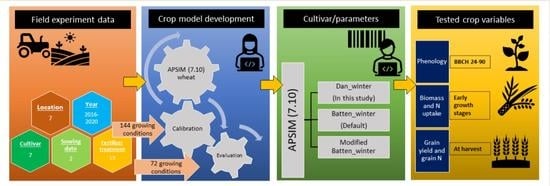Performance of APSIM to Simulate the Dynamics of Winter Wheat Growth, Phenology, and Nitrogen Uptake from Early Growth Stages to Maturity in Northern Europe
Abstract
1. Introduction
2. Results
2.1. Calibration and Evaluation of Phenology
2.2. Calibration and Evaluation of Biomass and N Uptake
2.3. Calibration and Evaluation of Grain Yield and Grain Nitrogen
2.4. Inter- and Intra-Annual Variability in Observed and Simulated Data
2.5. Sensitivity Analysis to Assess Overestimation of N Uptake
3. Discussion
3.1. Performance of APSIM for Simulating Phenology and Early Stage Biomass and N Uptake
3.2. Grain Yield and Grain N Simulation Capacity of APSIM
4. Materials and Methods
4.1. Description of Field Trials
4.2. Data Collection
4.3. Soil Characteristics
4.4. Weather Data
4.5. APSIM Model Description
4.6. APSIM Winter Wheat Model Calibration and Evaluation
4.7. Sensitivity Analysis
4.8. Model Performance Determinants
5. Conclusions
Supplementary Materials
Author Contributions
Funding
Institutional Review Board Statement
Informed Consent Statement
Data Availability Statement
Acknowledgments
Conflicts of Interest
References
- Lobell, D.B. The case of the missing wheat. Environ. Res. Lett. 2012, 7, 021002. [Google Scholar] [CrossRef]
- Supit, I.; Van Diepen, C.A.; De Wit, A.J.W.; Kabat, P.; Baruth, B.; Ludwig, F. Recent changes in the climatic yield potential of various crops in Europe. Agric. Syst. 2010, 103, 683–694. [Google Scholar] [CrossRef]
- Matson, P.A.; Parton, W.J.; Power, A.G.; Swift, M.J. Agricultural intensification and ecosystem properties. Science 1997, 277, 504–509. [Google Scholar] [CrossRef]
- Musacchio, A.; Re, V.; Mas-Pla, J.; Sacchi, E. EU Nitrates Directive, from theory to practice: Environmental effectiveness and influence of regional governance on its performance. Ambio 2020, 49, 504–516. [Google Scholar] [CrossRef]
- European Environment Agency. Nutrients in Freshwater in Europe. 2018. Available online: https://www.eea.europa.eu/data-and-maps/indicators/nutrients-in-freshwater/nutrients-in-freshwater-assessment-published-9 (accessed on 11 May 2022).
- Biernat, L.; Taube, F.; Vogeler, I.; Reinsch, T.; Kluss, C.; Loges, R. Is organic agriculture in line with the EU-Nitrate directive? On-farm nitrate leaching from organic and conventional arable crop rotations. Agric. Ecosyst. Environ. 2020, 298, 106964. [Google Scholar] [CrossRef]
- Greer, K.D.; Pittelkow, C.M. Linking Nitrogen Losses with Crop Productivity in Maize Agroecosystems. Front. Sustain. Food Syst. 2018, 2, 29. [Google Scholar] [CrossRef]
- Öborn, I.; Edwards, A.C.; Witter, E.; Oenema, O.; Ivarsson, K.; Withers, P.J.A.; Nilsson, S.I.; Stinzing, A.R. Element balances as a tool for sustainable nutrient management: A critical appraisal of their merits and limitations within an agronomic and environmental context. Eur. J. Agron. 2003, 20, 211–225. [Google Scholar] [CrossRef]
- Qi, A.M.; Murray, P.J.; Richter, G.M. Modelling productivity and resource use efficiency for grassland ecosystems in the UK. Eur. J. Agron. 2017, 89, 148–158. [Google Scholar] [CrossRef]
- Rossel, R.A.V.; McBratney, A.B. Soil chemical analytical accuracy and costs: Implications from precision agriculture. Aust. J. Exp. Agric. 1998, 38, 765–775. [Google Scholar] [CrossRef]
- Wallach, D.; Makowski, D.; Jones, J.W. Working with Dynamic Crop Models: Evaluation, Analysis, Parameterization, and Applications, 1st ed.; Elsevier: Amsterdam, The Netherlands; Boston, MA, USA, 2006; p. 462. [Google Scholar]
- Kristensen, K.; Schelde, K.; Olesen, J.E. Winter wheat yield response to climate variability in Denmark. J. Agric. Sci. 2011, 149, 33–47. [Google Scholar] [CrossRef]
- Ghaley, B.B.; Wosten, H.; Olesen, J.E.; Schelde, K.; Baby, S.; Karki, Y.K.; Borgesen, C.D.; Smith, P.; Yeluripati, J.; Ferrise, R.; et al. Simulation of Soil Organic Carbon Effects on Long-Term Winter Wheat (Triticum aestivum) Production Under Varying Fertilizer Inputs. Front. Plant Sci. 2018, 9, 1158. [Google Scholar] [CrossRef] [PubMed]
- Mesbah, M.; Pattey, E.; Jego, G. A model-based methodology to derive optimum nitrogen rates for rainfed crops—A case study for corn using STICS in Canada. Comput. Electron. Agric. 2017, 142, 572–584. [Google Scholar] [CrossRef]
- Parsons, D.; Nicholson, C.F.; Blake, R.W.; Ketterings, Q.M.; Ramirez-Aviles, L.; Fox, D.G.; Tedeschi, L.O.; Cherney, J.H. Development and evaluation of an integrated simulation model for assessing smallholder crop-livestock production in Yucatan, Mexico. Agric. Syst. 2011, 104, 1–12. [Google Scholar] [CrossRef]
- Phelan, D.C.; Harrison, M.T.; McLean, G.; Cox, H.; Pembleton, K.G.; Dean, G.J.; Parsons, D.; Richter, M.E.A.; Pengilley, G.; Hinton, S.J.; et al. Advancing a farmer decision support tool for agronomic decisions on rainfed and irrigated wheat cropping in Tasmania. Agric. Syst. 2018, 167, 113–124. [Google Scholar] [CrossRef]
- Gyldengren, J.G.; Abrahamsen, P.; Olesen, J.E.; Styczen, M.; Hansen, S.; Gislum, R. Effects of winter wheat N status on assimilate and N partitioning in the mechanistic agroecosystem model DAISY. J. Agron. Crop Sci. 2020, 206, 784–805. [Google Scholar] [CrossRef]
- Cichota, R.; Vogeler, I.; Werner, A.; Wigley, K.; Paton, B. Performance of a fertiliser management algorithm to balance yield and nitrogen losses in dairy systems. Agric. Syst. 2018, 162, 56–65. [Google Scholar] [CrossRef]
- Khaembah, E.N.; Cichota, R.; Vogeler, I. Simulation of management strategies to mitigate nitrogen losses from crop rotations in Southland, New Zealand. J. Sci. Food Agric. 2021, 101, 4241–4249. [Google Scholar] [CrossRef]
- Wallach, D. Crop Model Calibration: A Statistical Perspective. Agron. J. 2011, 103, 1144–1151. [Google Scholar] [CrossRef]
- Asseng, S.; Ewert, F.; Rosenzweig, C.; Jones, J.W.; Hatfield, J.L.; Ruane, A.C.; Boote, K.J.; Thorburn, P.J.; Rotter, R.P.; Cammarano, D.; et al. Uncertainty in simulating wheat yields under climate change. Nat. Clim. Change 2013, 3, 827–832. [Google Scholar] [CrossRef]
- Rötter, R.P.; Palosuo, T.; Kersebaum, K.C.; Angulo, C.; Bindi, M.; Ewert, F.; Ferrise, R.; Hlavinka, P.; Moriondo, M.; Nendel, C.; et al. Simulation of spring barley yield in different climatic zones of Northern and Central Europe: A comparison of nine crop models. Field Crop Res. 2012, 133, 23–36. [Google Scholar] [CrossRef]
- Gaydon, D.S.; Balwinder-Singh Wang, E.; Poulton, P.L.; Ahmad, B.; Ahmed, F.; Akhter, S.; Ali, I.; Amarasingha, R.; Chaki, A.K.; Chen, C.; et al. Evaluation of the APSIM model in cropping systems of Asia. Field Crops Res. 2017, 204, 52–75. [Google Scholar] [CrossRef]
- Morel, J.; Parsons, D.; Halling, M.A.; Kumar, U.; Peake, A.; Bergkvist, G.; Brown, H.; Hetta, M. Challenges for Simulating Growth and Phenology of Silage Maize in a Nordic Climate with APSIM. Agronomy 2020, 10, 645. [Google Scholar] [CrossRef]
- Vogeler, I.; Jensen, J.L.; Thomsen, I.K.; Labouriau, R.; Hansen, E.M. Fertiliser N rates interact with sowing time and catch crops in cereals and affect yield and nitrate leaching. Eur. J. Agron. 2021, 124, 126244. [Google Scholar] [CrossRef]
- Kumar, U.; Morel, J.; Bergkvist, G.; Palosuo, T.; Gustavsson, A.M.; Peake, A.; Brown, H.; Ahmed, M.; Parsons, D. Comparative Analysis of Phenology Algorithms of the Spring Barley Model in APSIM 7.9 and APSIM Next Generation: A Case Study for High Latitudes. Plants 2021, 10, 443. [Google Scholar] [CrossRef]
- Seidel, S.J.; Palosuo, T.; Thorburn, P.; Wallach, D. Towards improved calibration of crop models—Where are we now and where should we go? Eur. J. Agron. 2018, 94, 25–35. [Google Scholar] [CrossRef]
- Christensen, B.T.; Jensen, J.L.; Thomsen, I.K. Impact of Early Sowing on Winter Wheat Receiving Manure or Mineral Fertilizers. Agron. J. 2017, 109, 1312–1322. [Google Scholar] [CrossRef]
- Justes, E.; Mary, B.; Meynard, J.M.; Machet, J.M.; Thelierhuche, L. Determination of a Critical Nitrogen Dilution Curve for Winter-Wheat Crops. Ann. Bot. 1994, 74, 397–407. [Google Scholar] [CrossRef]
- Yakoub, A.; Lloveras, J.; Biau, A.; Lindquist, J.L.; Lizaso, J.I. Testing and improving the maize models in DSSAT: Development, growth, yield, and N uptake. Field Crop Res. 2017, 212, 95–106. [Google Scholar] [CrossRef]
- Grindlay, D.J.C. Towards an explanation of crop nitrogen demand based on the optimization of leaf nitrogen per unit leaf area. J. Agric. Sci. 1997, 128, 377–396. [Google Scholar] [CrossRef]
- Zhao, Z.G.; Wang, E.L.; Wang, Z.M.; Zang, H.C.; Liu, Y.P.; Angus, J.F. A reappraisal of the critical nitrogen concentration of wheat and its implications on crop modeling. Field Crop Res. 2014, 164, 65–73. [Google Scholar] [CrossRef]
- Lemaire, G.; Jeuffroy, M.H.; Gastal, F. Diagnosis tool for plant and crop N status in vegetative stage theory and practices for crop N management. Eur. J. Agron. 2008, 28, 614–624. [Google Scholar] [CrossRef]
- Rueda-Ayala, V.P.; Pena, J.M.; Hoglind, M.; Bengochea-Guevara, J.M.; Andujar, D. Comparing UAV-Based Technologies and RGB-D Reconstruction Methods for Plant Height and Biomass Monitoring on Grass Ley. Sensors 2019, 19, 535. [Google Scholar] [CrossRef] [PubMed]
- Porter, J.R. AFRCWHEAT2: A model of the growth and development of wheat incorporating responses to water and nitrogen. Eur. J. Agron. 1993, 2, 69–82. [Google Scholar] [CrossRef]
- Hansen, S.; Jensen, H.E.; Nielsen, N.E.; Svendsen, H. Simulation of Nitrogen Dynamics and Biomass Production in Winter-Wheat Using the Danish Simulation-Model Daisy. Fertil. Res. 1991, 27, 245–259. [Google Scholar] [CrossRef]
- King, J.; Gay, A.; Sylvester-Bradley, R.; Bingham, I.; Foulkes, J.; Gregory, P.; Robinson, D. Modelling cereal root systems for water and nitrogen capture: Towards an economic optimum. Ann. Bot. 2003, 91, 383–390. [Google Scholar] [CrossRef] [PubMed]
- Van Oort, P.A.J.; Zhang, T.Y.; De Vries, M.E.; Heinemann, A.B.; Meinke, H. Correlation between temperature and phenology prediction error in rice (Oryza sativa, L.). Agric. For. Meteorol. 2011, 151, 1545–1555. [Google Scholar] [CrossRef]
- Zhang, T.Y.; Zhu, J.; Yang, X.G. Non-stationary thermal time accumulation reduces the predictability of climate change effects on agriculture. Agric. Forest Meteorol. 2008, 148, 1412–1418. [Google Scholar] [CrossRef]
- Wöhling, T.; Gayler, S.; Priesack, E.; Ingwersen, J.; Wizemann, H.D.; Hogy, P.; Cuntz, M.; Attinger, S.; Wulfmeyer, V.; Streck, T. Multiresponse, multiobjective calibration as a diagnostic tool to compare accuracy and structural limitations of five coupled soil-plant models and CLM3.5. Water Resour. Res. 2013, 49, 8200–8221. [Google Scholar] [CrossRef]
- Lancashire, P.D.; Bleiholder, H.; Vandenboom, T.; Langeluddeke, P.; Stauss, R.; Weber, E.; Witzenberger, A. A Uniform Decimal Code for Growth-Stages of Crops and Weeds. Ann. Appl. Biol. 1991, 119, 561–601. [Google Scholar] [CrossRef]
- Buchmann, N.B.; Joseffson, H.; Cowe, A.A. Performance of European Artificial Neural Network (ANN) Calibrations for Moisture and Protein in Cereals Using the Danish Near-Infrared Transmission (NIT) Network. Cereal Chem. 2001, 78, 572–577. [Google Scholar] [CrossRef]
- Jones, D.B. Factors for Converting Percentages of Nitrogen in Foods and Feeds into Percentages of Protein; Circular No. 183; US Department of Agriculture: Washington, DC, USA, 1941.
- Adhikari, K.; Kheir, R.B.; Grev, M.B.; Bocher, P.K.; Malone, B.P.; Minasny, B.; McBratney, A.B.; Greve, M.H. High-Resolution 3-D Mapping of Soil Texture in Denmark. Soil Sci. Soc. Am. J. 2013, 77, 860–876. [Google Scholar] [CrossRef]
- Haarder, E.B.; Olsen, P.; Jakobsen, P.R.; Albers, C.N.; Iversen, B.V.; Greve, M.H.; Plauborg, F.; Kørup, K.; Skov, M.; Gudmundsson, L.; et al. The Danish Pesticide Leaching Assessment Programme Site Characterization and Monitoring Design for the Lund Test Field; Geological Survey of Denmark and Greenland Danish Ministry of Energy, Utilities and Climate, Department of Agroecology Aarhus University: Copenhagen, Denmark, 2021; p. 53.
- Holzworth, D.P.; Huth, N.I.; Devoil, P.G.; Zurcher, E.J.; Herrmann, N.I.; McLean, G.; Chenu, K.; Van Oosterom, E.J.; Snow, V.; Murphy, C.; et al. APSIM—Evolution towards a new generation of agricultural systems simulation. Environ. Modell. Softw. 2014, 62, 327–350. [Google Scholar] [CrossRef]
- Asseng, S.; Van Keulen, H.; Stol, W. Performance and application of the APSIM Nwheat model in the Netherlands. Eur. J. Agron. 2000, 12, 37–54. [Google Scholar] [CrossRef]
- Keating, B.A.; Carberry, P.S.; Hammer, G.L.; Probert, M.E.; Robertson, M.J.; Holzworth, D.; Huth, N.I.; Hargreaves, J.N.G.; Meinke, H.; Hochman, Z.; et al. An overview of APSIM, a model designed for farming systems simulation. Eur. J. Agron. 2003, 18, 267–288. [Google Scholar] [CrossRef]
- Palosuo, T.; Kersebaum, K.C.; Angulo, C.; Hlavinka, P.; Moriondo, M.; Olesen, J.E.; Patil, R.H.; Ruget, F.; Rumbaur, C.; Takáč, J.; et al. Simulation of winter wheat yield and its variability in different climates of Europe: A comparison of eight crop growth models. Eur. J. Agron. 2011, 35, 103–114. [Google Scholar] [CrossRef]
- Berghuijs, H.N.C.; Weih, M.; Werf, W.; Karley, A.J.; Adam, E.; Villegas-Fernandez, A.M.; Kiær, L.P.; Newton, A.C.; Scherber, C.; Tavoletti, S.; et al. Calibrating and testing APSIM for wheat-faba bean pure cultures and intercrops across Europe. Field Crops Res. 2021, 264, 108088. [Google Scholar] [CrossRef]
- Ahmed, M.; Akram, M.N.; Asim, M.; Aslam, M.; Hassamn, F.; Higgins, S.; Stockle, C.O.; Hoogenboom, G. Calibration and validation of APSIM-Wheat and CERES-Wheat for spring wheat under rainfed conditions: Models evaluation and application. Comput. Electron. Agric. 2016, 123, 384–401. [Google Scholar] [CrossRef]
- Chaki, A.P.; Gaydon, D.S.; Dalal, R.C.; Bellotti, W.D.; Gathala, M.K.; Hossain, A.; Menzies, N.W. How we used APSIM to simulate conservation agriculture practices in the rice-wheat system of the Eastern Gangetic Plains. Field Crops Res. 2022, 275, 108344. [Google Scholar] [CrossRef]
- Bromand, B.; Hansen, S.M.S. Statens Planteavlsforsøg, Landbrug, Grøn Viden, 1995; nr 149. Available online: https://dcapub.au.dk/djfpdf/gvma149.pdf (accessed on 5 April 2022).
- Zadoks, J.C.; Chang, T.T.; Konzak, C.F. A decimal code for the growth stages of cereals. Weed Res. 1974, 14, 415–421. [Google Scholar] [CrossRef]
- Bassu, S.; Brisson, N.; Durand, J.L.; Boote, K.; Lizaso, J.; Jones, J.W.; Rosenzweig, C.; Ruane, A.C.; Adam, M.; Baron, C.; et al. How do various maize crop models vary in their responses to climate change factors? Global Change Biol. 2014, 20, 2301–2320. [Google Scholar] [CrossRef]
- Manschadi, A.M.; Eitzinger, J.; Breisch, M.; Fuchs, W.; Neubauer, T.; Soltani, A. Full Parameterisation Matters for the Best Performance of Crop Models: Inter-comparison of a Simple and a Detailed Maize Model. Int. J. Plant Prod. 2021, 15, 61–78. [Google Scholar] [CrossRef]
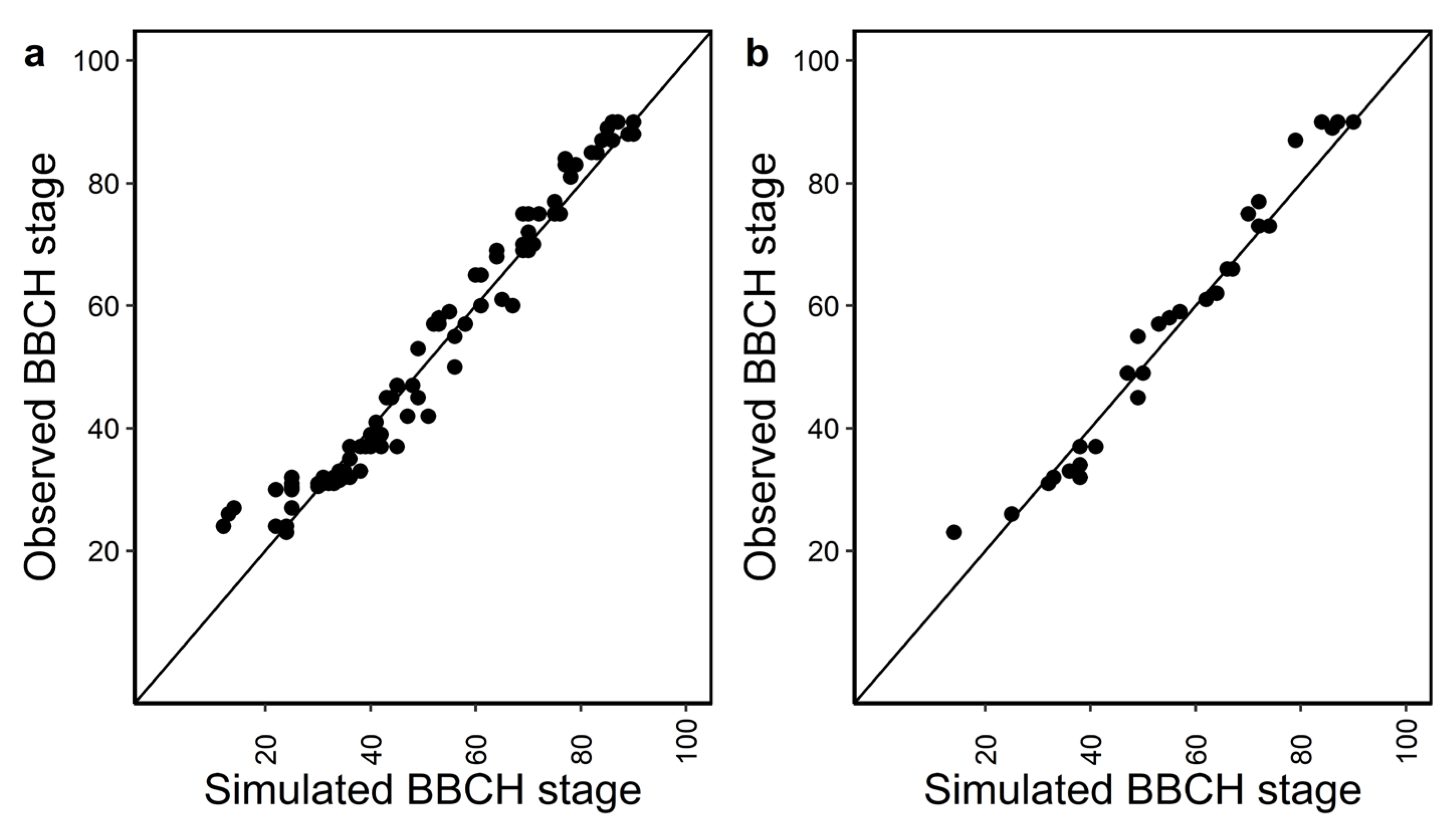

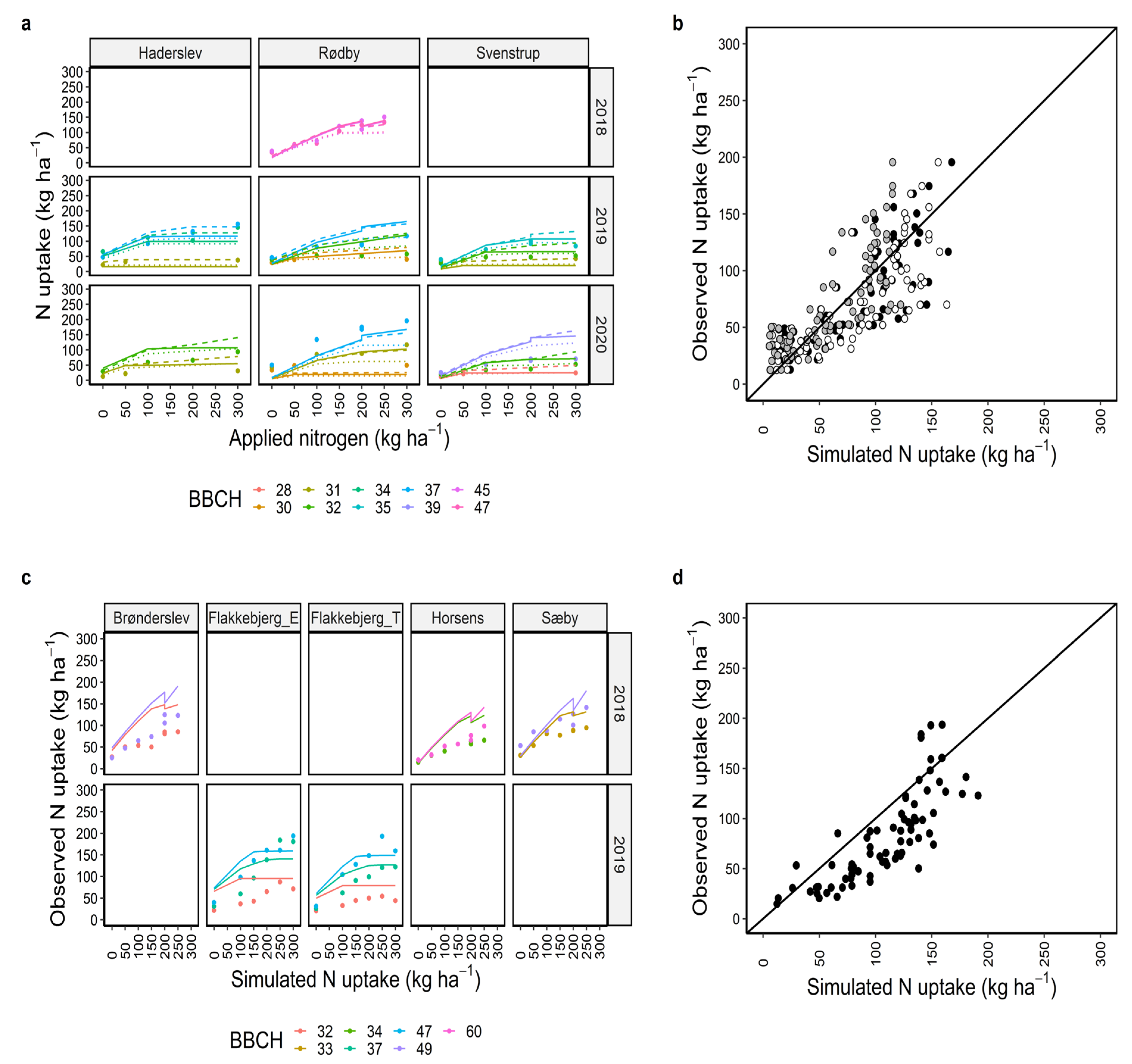
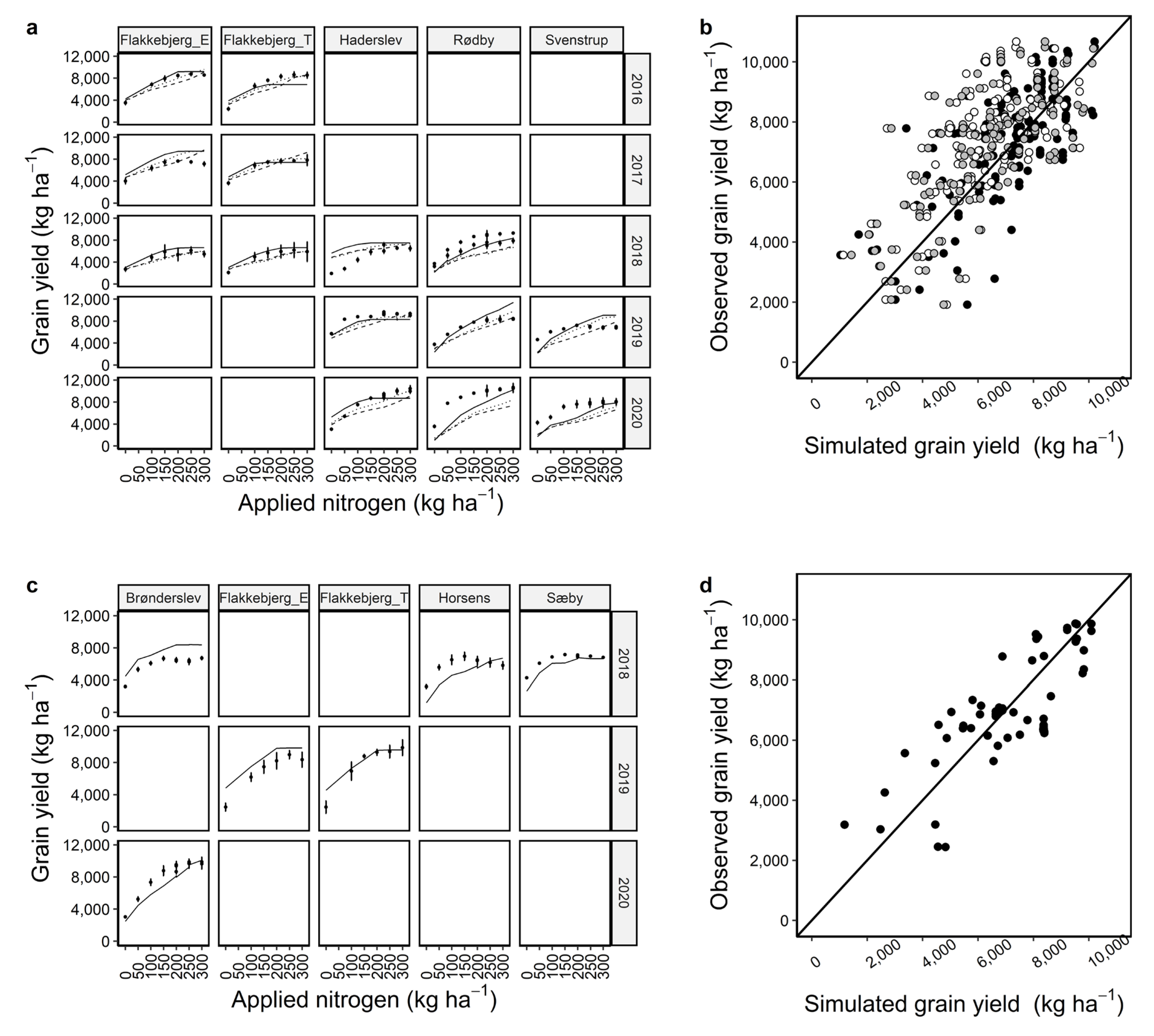
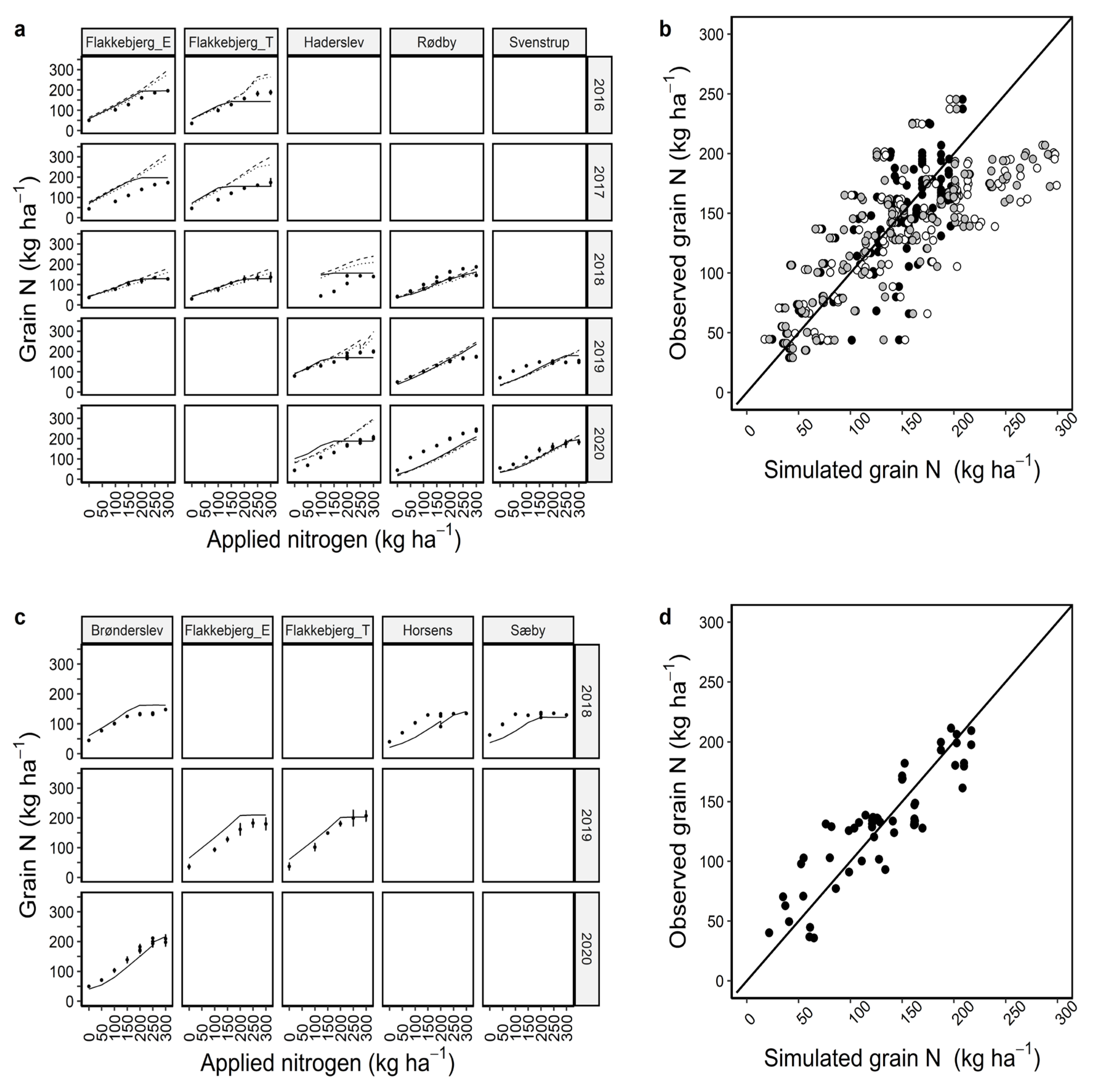
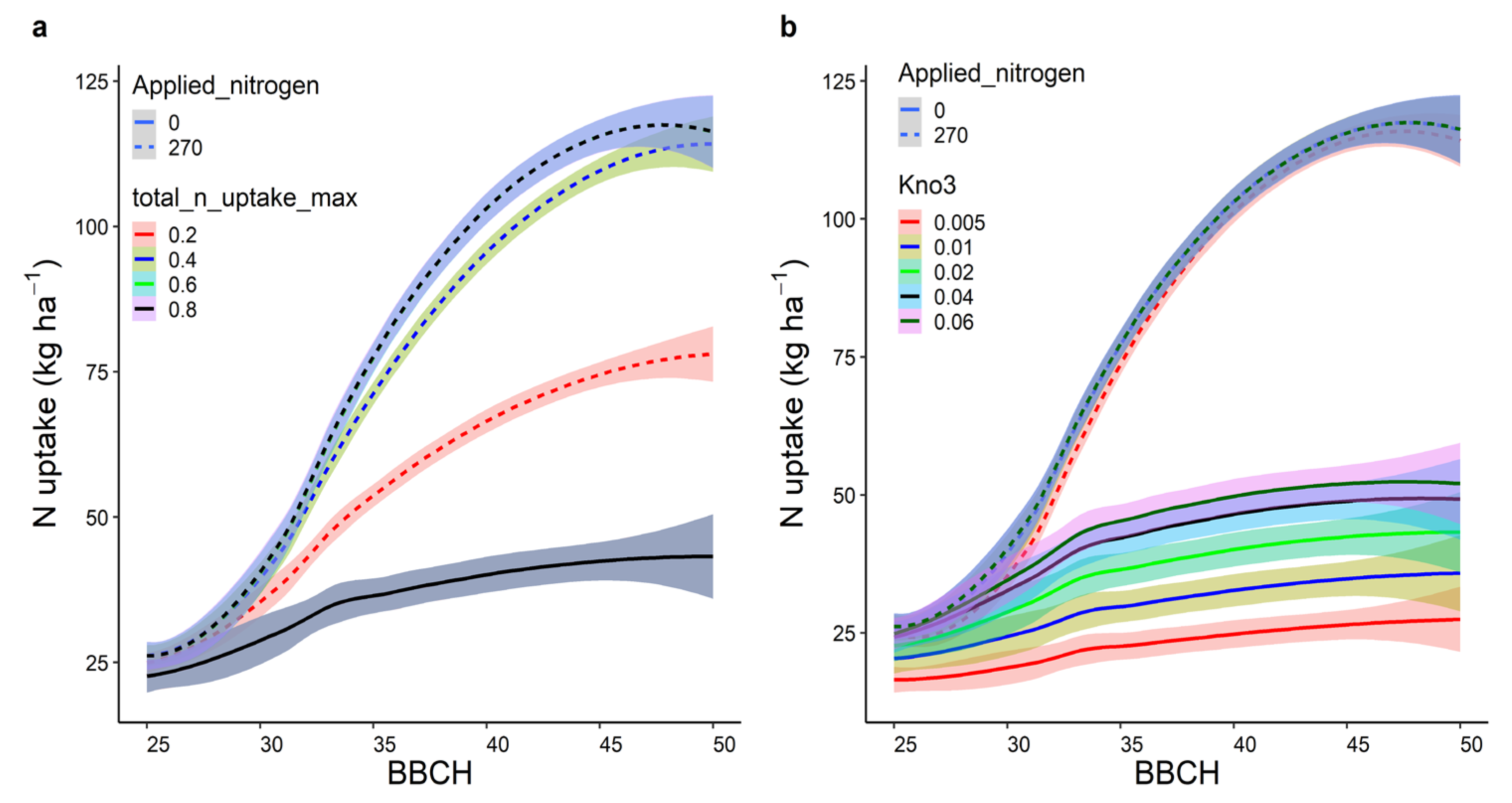
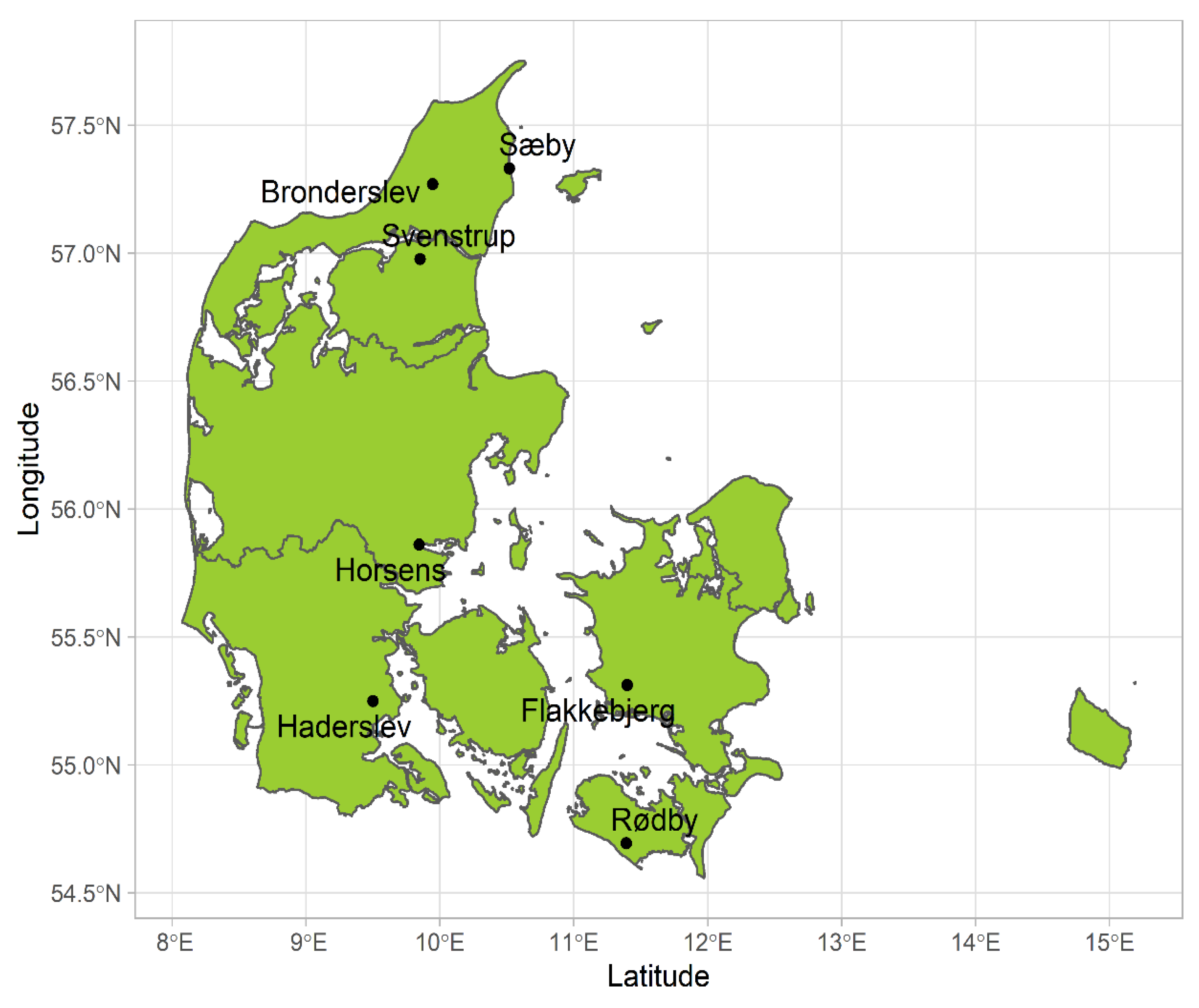
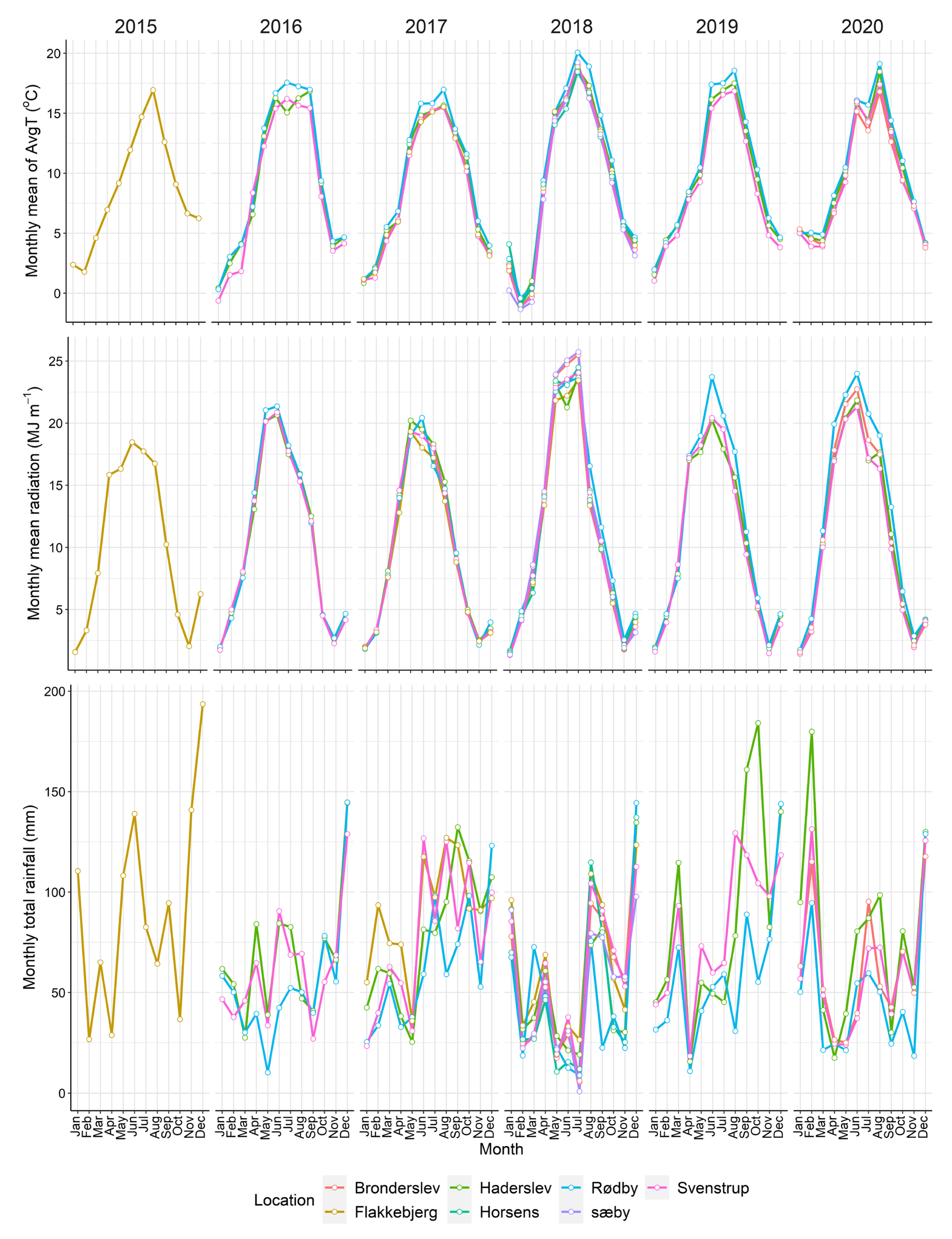
| Dan_Winter | Default Cultivar in APSIM (Batten_Winter) | Modified Cultivar Used in [25] | ||
|---|---|---|---|---|
| Calibration | Validation | |||
| Phenology | ||||
| r2 | 0.97 | 0.97 | 0.095 | 0.97 |
| NSE | 0.97 | 0.97 | −0.77 | 0.95 |
| * RMSE (BBCH) | 4.15 | 3.98 | 30.3 | 5 |
| Biomass at early growth stages (~28–47 BBCH) | ||||
| r2 | 0.65 | 0.59 | 0.57 | |
| NSE | 0.47 | 0.4 | 0.39 | |
| RMSE (kg ha−1) | 1510 | 1607 | 1615 | |
| N uptake at early growth stages (~28–60 BBCH) | ||||
| r2 | 0.66 | 0.64 | 0.62 | 0.63 |
| NSE | 0.57 | 0.24 | 0.46 | 0.58 |
| RMSE (kg ha−1) | 28 | 39 | 31 | 27 |
| Grain yield at harvest | ||||
| r2 | 0.51 | 0.61 | 0.48 | 0.51 |
| NSE | 0.43 | 0.51 | 0.054 | 0.28 |
| RMSE (kg ha−1) | 1491 | 1296 | 1923 | 1674 |
| Grain N: N uptake at harvest | ||||
| r2 | 0.6 | 0.688 | −0.072 | 0.56 |
| NSE | 0.55 | 0.76 | 0.54 | 0.16 |
| RMSE (kg ha−1) | 32 | 25 | 50 | 44 |
| Category of Variability | Location | Year | BBCH * (Observed) | Applied Nitrogen (kg ha−1) | Biomass (kg ha−1) | N uptake (kg ha−1) | |||
|---|---|---|---|---|---|---|---|---|---|
| Observed | Simulation | Observed | Simulation | ||||||
| Across locations | 2018–2020 | 28–49 | 0–300 | Mean | 3169 | 4090 | 77 | 82 | |
| SD | 2062 | 2674 | 44 | 46 | |||||
| Inter-annual | Rødby | 2018–2020 | 28–47 | 0–300 | Mean | 4298 | 3946 | 85 | 85 |
| SD | 2124 | 2443 | 45 | 49 | |||||
| Inter-annual | Svenstrup | 2019–2020 | 28–39 | 0–300 | Mean | 1516 | 2556 | 48 | 62 |
| SD | 735 | 2218 | 24 | 42 | |||||
| Inter-annual | Haderselv | 2019 | 31 | 300 | 845 | 406 | 37 | 16 | |
| 2020 | 31 | 300 | 1196 | 1680 | 31 | 55 | |||
| SD | 248 | 901 (263%) | 4 | 28 (550%) | |||||
| Inter-annual | Svenstrup | 2019 | 32 | 300 | 1166 | 2011 | 51 | 66 | |
| 2020 | 32 | 300 | 1453 | 2157 | 52 | 71 | |||
| SD | 203 | 103 (49%) | 0.7 | 3.5 (400%) | |||||
| Intra-annual | Rødby | 2020 | 31 | 200 | 3380 | 3392 | 88 | 94 | |
| 37 | 200 | 8067 | 7591 | 168 | 134 | ||||
| SD | 3315 | 2969 (10%) | 57 | 28 (50%) | |||||
| Intra-annual | Haderslev | 2019 | 34 | 200 | 3639 | 3930 | 102 | 100 | |
| 37 | 200 | 5319 | 5180 | 128 | 116 | ||||
| SD | 1188 | 884 (26%) | 18 | 11 (39%) | |||||
| Location | Year | Date of Measurement | DAS | Biomass | N Uptake | Grain Yield | Grain N | Phenology Observation (BBCH) |
|---|---|---|---|---|---|---|---|---|
| Calibration data set | ||||||||
| Rødby | 2018 | 23 May 2018 | 243 | x | x | |||
| 23 July 2018 | 304 | x | x | |||||
| 23 May 2018 | 239 | x | x | |||||
| 23 July 2018 | 300 | x | x | 24–90 (9 stages) | ||||
| 2019 | 8 April 2019 | 203 | x | x | ||||
| 23 April 2019 | 218 | x | x | |||||
| 6 May 2019 | 231 | x | x | |||||
| 27 July 2019 | 313 | x | x | 27–90 (9 stages) | ||||
| 2020 | 31 March 2020 | 191 | x | x | ||||
| 22 April 2020 | 213 | x | x | |||||
| 11 May 2020 | 232 | x | x | |||||
| 2 August 2020 | 315 | x | x | 23–90 (7 stages) | ||||
| Haderslev | 2018 | 2 August 2018 | 310 | x | x | 24–90 (7 stages) | ||
| 2019 | 3 April 2019 | 189 | x | x | ||||
| 7 May 2019 | 223 | x | x | |||||
| 14 May 2019 | 230 | x | x | 27–90 (6 stages) | ||||
| 27 August 2019 | 335 | x | x | |||||
| 2020 | 22 April 2020 | 209 | x | x | ||||
| 13 May 2020 | 230 | x | x | |||||
| 12 August 2020 | 321 | x | x | 31–90 (5 stages) | ||||
| Svenstrup | 2019 | 15 April 2019 | 195 | x | x | |||
| 29 April 2019 | 209 | x | x | |||||
| 15 May 2019 | 225 | x | x | |||||
| 30 August 2019 | 332 | x | x | 26–90 (8 stages) | ||||
| 2020 | 14 April 2020 | 206 | x | x | ||||
| 28 April 2020 | 220 | x | x | |||||
| 27 May 2020 | 249 | x | x | |||||
| 25 August 2020 | 339 | x | x | 31–90 (8 stages) | ||||
| Flakkebjerg_T | 2016 | At final harvest | x | x | 31–88 (11 stages) | |||
| 2017 | At final harvest | x | x | 30–85 (8 stages) | ||||
| 2018 | At final harvest | x | x | 30–89 (10 stages) | ||||
| Flakkebjerg_E | 2016 | At final harvest | x | x | 32–88 (9 stages) | |||
| 2017 | At final harvest | x | x | 30–85 (8 stages) | ||||
| 2018 | At final harvest | x | x | 30–89 (10 stages) | ||||
| Evaluation data set | ||||||||
| Brønderslev | 2018 | 15 May 2018 | 252 | x | x | |||
| 29 May 2018 | 266 | x | x | |||||
| 30 July 2018 | 328 | x | x | 26–90 (9 stages) | ||||
| 2020 | 12 August 2020 | 320 | x | x | 32–90 (9 stages) | |||
| Horsens | 2018 | 3 May 2018 | 236 | x | x | |||
| 16 May 2018 | 249 | x | x | |||||
| 25 May 2018 | 258 | x | x | |||||
| 23 July 2018 | 317 | x | x | 30–90 (9 stages) | ||||
| Sæby | 2018 | 15 May 2018 | 252 | x | x | |||
| 28 May 2018 | 265 | x | x | |||||
| 3 August 2018 | 332 | x | x | 26–90 (9 stages) | ||||
| Flakkebjerg_T and E | 2019 | 1 May 2019 | 238 | x | ||||
| 15 May 2019 | 252 | x | ||||||
| 27 May 2019 | 264 | x | 32–47 (3 stages) | |||||
| At final harvest | x | x | ||||||
| Location | Depth (cm) | Bulk Densit (g/cc) | Wilting Point (mm/mm) | Field Capacity (mm/mm) | Saturation (mm/mm) | Organic Carbon (%) | pH | Sand (%) | Silt (%) | Clay (%) | − (kg/ha) | + (kg/ha) | PAW (mm) |
|---|---|---|---|---|---|---|---|---|---|---|---|---|---|
| Rødby | 0–25 | 1.49 | 0.08 | 0.28 | 0.44 | 3.4 | 7.7 | 76 | 11 | 11 | 0.03 | 0.12 | |
| 50–160 | 1.75 | 0.10 | 0.22 | 0.34 | 0.9 | 8.2 | 62 | 10 | 10 | 0.03 | 0.03 | 217 | |
| Haderselv | 0–28 | 1.43 | 0.09 | 0.30 | 0.46 | 5.0 | 7.4 | 67 | 16 | 14 | 0.09 | 0.15 | |
| 70–160 | 1.47 | 0.15 | 0.37 | 0.44 | 0.6 | 6.0 | 44 | 23 | 33 | 0.06 | 0.05 | 246 | |
| Svenstrup | 0–22 | 1.50 | 0.08 | 0.30 | 0.43 | 4.5 | 6.2 | 77 | 12 | 8 | 0.08 | 0.15 | |
| 50–160 | 1.90 | 0.07 | 0.22 | 0.28 | 0.5 | 6.4 | 79 | 8 | 14 | 0.09 | 0.05 | 187 | |
| Flakkebjerg | 0–20 | 1.53 | 0.09 | 0.26 | 0.40 | 1.4 | 6.0 | 77 | 17 | 7 | 2.00 | 5.00 | |
| 50–160 | 1.71 | 0.12 | 0.27 | 0.37 | 0.2 | 6.0 | 69 | 20 | 11 | 0.00 | 0.67 | 174 | |
| Bronderslev | 0–28 | 1.31 | 0.08 | 0.41 | 0.45 | 3.7 | 7.5 | 57 | 30 | 7 | 0.08 | 0.15 | |
| 60–160 | 1.54 | 0.02 | 0.29 | 0.38 | 0.4 | 5.7 | 78 | 19 | 3 | 0.07 | 0.05 | 325 | |
| Horsens | 0–26 | 1.42 | 0.07 | 0.30 | 0.43 | 1.5 | 6.2 | 58 | 30 | 9 | 0.08 | 0.15 | |
| 50–160 | 1.68 | 0.07 | 0.21 | 0.31 | 0.1 | 7.1 | 70 | 23 | 9 | 0.08 | 0.05 | 172 | |
| Sæby | 0–30 | 1.30 | 0.08 | 0.35 | 0.44 | 2.4 | 6.8 | 51 | 36 | 9 | 0.09 | 0.15 | |
| 60–160 | 1.81 | 0.09 | 0.26 | 0.30 | 0.1 | 5.6 | 58 | 28 | 14 | 0.08 | 0.05 | 223 |
| Parameter | Unit | Parameter Description | Default Value | Calibrated Value |
|---|---|---|---|---|
| Phenology | ||||
| vern_sens | - | Sensitivity to vernalisaiton | 1.5 | 4.65 |
| photop_sens | - | Sensitivity to photoperiod | 3 | 3.35 |
| tt-end_of_juvenile | °Cd | Thermal time required from emergence to start of panicle/spikelet/floral initiation | 400 | 450 |
| tt_start_grain_fill | °Cd | Thermal time required from start of grain filling to end of grain filling | 545 | 750 |
| Biomass | ||||
| y_sla_max | mm2 g−1 | Regulates specific leaf area | 27,000, 22,000 | 24,500, 18,000 |
| initial_tpla | mm2 plant−1 | Intial plant leaf area after emergence | 200 | 100 |
| Grain Yield | ||||
| grains_per_gram_stem | grain/g stem weight | Regulates number of grains per gram of stem weight at the end of flowering (zadok stage 65) | 25 | 37 |
| max_grain_size | g | Regulates maximum weight of individual grain | 0.041 | 0.045 |
| potential_grain_filling_rate | g grain−1 day−1 | Regulates potential daily grain filling rate from grain filling to maturity | 0.002 | 0.0038 |
| potential_grain_growth_rate | g grain−1 day−1 | Regulates growth rate from flowering to start of grain filling | 0.001 | 0.0006 |
| Grain N | ||||
| potential_grain_n_filling_rate | g grain−1 day−1 | Regulates potential daily N filling rate to grain from grain filling to maturity | 0.000055 | 0.000035 |
Disclaimer/Publisher’s Note: The statements, opinions and data contained in all publications are solely those of the individual author(s) and contributor(s) and not of MDPI and/or the editor(s). MDPI and/or the editor(s) disclaim responsibility for any injury to people or property resulting from any ideas, methods, instructions or products referred to in the content. |
© 2023 by the authors. Licensee MDPI, Basel, Switzerland. This article is an open access article distributed under the terms and conditions of the Creative Commons Attribution (CC BY) license (https://creativecommons.org/licenses/by/4.0/).
Share and Cite
Kumar, U.; Hansen, E.M.; Thomsen, I.K.; Vogeler, I. Performance of APSIM to Simulate the Dynamics of Winter Wheat Growth, Phenology, and Nitrogen Uptake from Early Growth Stages to Maturity in Northern Europe. Plants 2023, 12, 986. https://doi.org/10.3390/plants12050986
Kumar U, Hansen EM, Thomsen IK, Vogeler I. Performance of APSIM to Simulate the Dynamics of Winter Wheat Growth, Phenology, and Nitrogen Uptake from Early Growth Stages to Maturity in Northern Europe. Plants. 2023; 12(5):986. https://doi.org/10.3390/plants12050986
Chicago/Turabian StyleKumar, Uttam, Elly Møller Hansen, Ingrid Kaag Thomsen, and Iris Vogeler. 2023. "Performance of APSIM to Simulate the Dynamics of Winter Wheat Growth, Phenology, and Nitrogen Uptake from Early Growth Stages to Maturity in Northern Europe" Plants 12, no. 5: 986. https://doi.org/10.3390/plants12050986
APA StyleKumar, U., Hansen, E. M., Thomsen, I. K., & Vogeler, I. (2023). Performance of APSIM to Simulate the Dynamics of Winter Wheat Growth, Phenology, and Nitrogen Uptake from Early Growth Stages to Maturity in Northern Europe. Plants, 12(5), 986. https://doi.org/10.3390/plants12050986




